Did you know that almost half of all invoices are paid late? Business leaders also report that client payment practices have gotten worse over the last year (Atradius). Many are hopeful this will turn around soon. Until that happens, agency leaders like you are thinking about how to make sure you get paid. After all, getting paid on time is important, especially if you want to grow your business. Having a good invoicing system on your side is key to reaching that goal.
How can automation make your agency more efficient and productive? Download “Agency Marketing Through Automation” to find out.
These eight do’s and don’ts can help you streamline your billing system and make it even easier for your clients to pay on time.
#1. Do: Set clear expectations around payment
No matter which invoicing platform you adopt, you should always have clear payment policies. Make sure you hash out client expectations around billing before you start work. If it’s been a while since you’ve established your payment policies, it doesn’t hurt to revisit them and make changes as needed now that your agency, client base, and monthly recurring revenue have grown.
Some clients may want monthly billing. Others may prefer you to invoice that big job you’re doing once you’ve wrapped everything up. If you’re doing a lot of work for a client, you’ll need a clear policy for how to bill them. Do they get one bill, or a bill for each service, product, or project you’re working on? As you take on more clients, you may realize that you need to create multiple billing policies for different types of accounts and projects.
Consider reviewing your terms of payment and late policies to determine if you can make any changes that will help you get paid on time. If your clients are always paying late, can you offer them options to split up payments? What happens when a client is late? Having clear policies and communicating them to clients can help streamline the billing process.
#2. Do: Use an invoicing system to automate billing
Now you have your billing policies hashed out. It’s time to put them to work with your chosen invoicing system.
The system should be able to help you automate some of the more tedious parts of invoicing. This might include generating and sending invoices for recurrent payments.
An invoicing system that integrates with other software you’re using can streamline this process. The billing software may also be able to draw data from marketing or sales to generate invoices.
Better yet, the right billing platform should make it easier for your clients to pay on time. They can see their invoices, then pay them the way they want to pay from the same dashboard.
#3. Don’t: Have separate billing systems for different services
Consolidation is the name of the game when it comes to your invoicing system. The right billing platform can make it simpler for your accounting team to pay your agency’s own bills. The platform can also reduce the number of vendors you’re paying. That means one bill in one place, not dozens of bills across several platforms.
This also works for you and your clients when it comes time to invoice them. Having all their bills in a centralized location makes it easy for your clients to find and pay them. An invoicing system with an integrated payment platform makes it even easier for them to pay on time.
Having separate bills for each service or having different departments send their own invoices means more work for your team. It can also create confusion on the client’s end. They might think they’ve already paid one bill, only to realize it was for a different project or service.
Make it simpler for everyone by pulling everything together under one banner.
#4. Do: Send automatic reminders and receipts
Your invoicing system should also be able to send automatic reminders and receipts. Receipts help both your team and the client keep track of what they’ve already paid. Automating them gets the receipt to the client faster—and it frees up your team’s time.
Automated reminders are important in a world where almost half of all invoices are paid late. Sometimes, all the client needs is a nudge—21 percent of clients pay an overdue invoice after the first reminder (Moula). Yet, if almost half of your clients are paying late, sending out those reminders is a significant drain on your accounting team’s time.
Invoicing system automation ensures your invoices and reminders go out on time, so you can get paid sooner. Your team has more time if they don’t need to send late notices to half your clients.
#5. Don’t: Forget the details
The devil is often in the details. You may remember to add the client’s billing information to the bill, but don’t forget to add your own details either. Your invoicing system should make this simple and easy to do.
The right platform can help by offering templates. It may even connect with other software you’re already using in your agency. An example is your sales CRM, which the billing platform can draw on to make sure a client’s details are correct.
Getting the details right is also important when it comes to putting the bill together. A platform that connects to your marketing software and other parts of your pipeline can add the right details for client purchases.
#6. Do: Make payment easy
Consolidation is one way of making it easy for your clients to pay their bills. Ensuring your invoicing system connects to your payment platform is another.
In this way, clients only need to sign into one dashboard to see and pay their bills. If they can pay their preferred way with just a couple of clicks, they’re more likely to pay sooner. You might even choose to offer partial payments or discounts for early payments (FitSmallBusiness).
That means fewer late payments. As an added bonus, your team spends less time tracking down unpaid invoices.
#7. Don’t: Underestimate the power of design
A professionally designed invoice can be impressive for your clients. It can also highlight the important details, such as the amount to pay and the due date. When those details stand out, your clients are more likely to pay sooner.
Design is also important because it represents your brand. A prevalent brand is important, even in the billing department. It makes you look professional, and it also helps clients remember you. If you’re also making it easy to pay their bills, they’re likely to think about how easy it is to work with you.
#8. Do: Use an invoicing system that lets you upsell
Another benefit of using an invoicing system that connects with marketing, sales, and other parts of your pipeline is that it can help you sell more. It lets your clients quickly and easily add more products to their baskets.
Your invoicing system could even help you make recommendations to the client. Using data about what other clients have bought, the platform can suggest solutions. In turn, that makes cross-selling and upselling easier for your agency sales team. When they do land the deal, it’s also easy for your billing department to add new line items to recurring bills.
Upgrade how you get paid
Test out these do’s and don’ts within your invoicing system, and spend less time chasing clients for unpaid invoices.
What if the invoicing platform you’re using isn’t offering you the tools you need, like consolidated billing or automation? It could be time to switch.
The right billing platform will help you get paid on time. In turn, you’ll free up more of your most valuable resources so you can focus on scaling your business.


